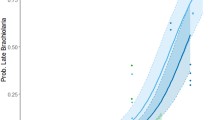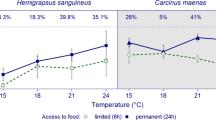Abstract
High densities of larvae have been found in areas of high primary production, but it remains unclear whether this is the result of hydrodynamics or of larval aggregative behaviour in the presence of food. In this study, we examined changes in the vertical distribution and swimming patterns of four-armed larvae of the sea-urchin Echinometra lucunter (Linnaeus) around food patches of a range of microalgal densities. We reared larvae in the laboratory in a high or low concentration of either single (Isochrysis galbana) or mixed (I. galbana, Dunaliella tertiolecta, Thalassiosira weissflogii) microalgal species. In Plexiglas cylinders, we experimentally constructed haloclines in which the salinity of the bottom water-layer was 33‰ and that of the top water-layer was 24‰. In a thin layer in the middle of the halocline, we inserted a food patch that consisted of 0, 2500, 5000 or 10 000 T. weissflogii cells ml−1. The presence of a food patch had a pronounced effect on the vertical distribution of larvae. This effect depended upon the algal density of the food patch and varied with dietary conditioning. The number of larvae that were above or within the patch decreased with increasing algal density, and was greater if larvae were reared in low-ration or single-species diets than in high-ration or mixed-species diets. Tracking of individual vertical swimming paths showed that within a few minutes, larvae swam into the patches of low algal density, and to positions just below the patches of the two higher algal densities, and remained there until the end of the experimental period. The greater number of algal cells in the digestive tracts of larvae from treatments with a food patch than in those without a patch confirmed that larvae were feeding on the microalgal cells of the patch. To our knowledge, this is the first study to experimentally show an aggregative behavioural response of invertebrate larvae to a food patch. Such a response may reduce the probability of food limitation and therefore enhance larval survival.
Similar content being viewed by others
Author information
Authors and Affiliations
Additional information
Received: 14 February 1997 / Accepted: 24 September 1997
Rights and permissions
About this article
Cite this article
Metaxas, A., Young, C. Responses of echinoid larvae to food patches of different algal densities. Marine Biology 130, 433–445 (1998). https://doi.org/10.1007/s002270050264
Issue Date:
DOI: https://doi.org/10.1007/s002270050264




